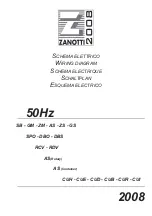
Page 8
Notes:
1. The minimum and maximum limits of the temperature range of your thermostat are
preset and locked by us. For refrigerator models, that range is 33
°
F to 40
°
F. For
freezers, the range is -25
°
C to -1
°
C. To reset these ranges, either call us or find
information on our website under
Troubleshooting
.
2. If the appliance is unplugged, has lost power, or is turned off, you must wait 3 to 5
minutes before restarting the unit. If you attempt to restart before this time delay, the
appliance will not start.
CARE OF THE APPLIANCE
DEFROSTING
There is usually no need to defrost the
refrigerator models
because any ice deposited on the
interior is automatically defrosted. Ice deposits on the inner back wall during compressor
operation. Later on, when the compressor is not operating, the ice defrosts and water drains
through the outlet in the inner back wall into the drain pan situated above the compressor where
it evaporates. If you see water building up in the rear of the unit, check that the drain trough is
not clogged. Use a pipe cleaner or a piece of flexible wire. During extremely hot and humid
weather, some ice may build up. If necessary, remove contents, unplug the unit and allow
defrosting. A hair dryer may facilitate the process.
Freezer models
require manual defrosting. No internal fans are present, and ice will build up
along the cooling coils. Periodically defrost the ice (recommended when the ice level reaches a
thickness of 1/4 to 1/2 inch).
NEVER USE A METAL INSTRUMENT
as you can damage the
cooling coils, which often cannot be repaired; this will also void your warranty. To defrost,
disconnect from the power supply, empty the contents, provide a tray in the bottom to collect
water, and use a hairdryer or other source of warm air to melt the ice (or leave the door open
and the power off for 24 to 48 hours).
CLEANING THE APPLIANCE
NOTE: To prevent the buildup of odors, clean the appliance about once a month. Follow the
procedure below for cleaning:
1. Disconnect from power.
2. Remove any parts that can be taken out of the cabinet, such as drawers.
3. Using a clean sponge or soft cloth, hand wash, rinse and dry removable parts and interior
surfaces thoroughly. Use a mild detergent in warm water. DO NOT use abrasive or harsh
cleansers such as window sprays, scouring cleansers, flammable fluids, cleaning waxes,
concentrated detergents, bleaches or cleansers containing petroleum products. DO NOT use
harsh cleaning tools such as paper towels or scouring pads, as these can scratch or damage
the surfaces of the refrigerator.
4. For stainless steel and painted metal exterior surfaces, use a clean sponge or soft cloth and
a mild detergent in warm water. DO NOT use abrasive or harsh cleaners, or cleaners containing
chlorine, as these can scratch or damage the material. Using a soft cloth, dry thoroughly.
5. To help with removing odors, you can use a mixture of warm water and baking soda (2 tbs to
1 qt of water) to wash the interior walls.
6. After cleaning, replace all of the parts that were removed from the appliance.


































